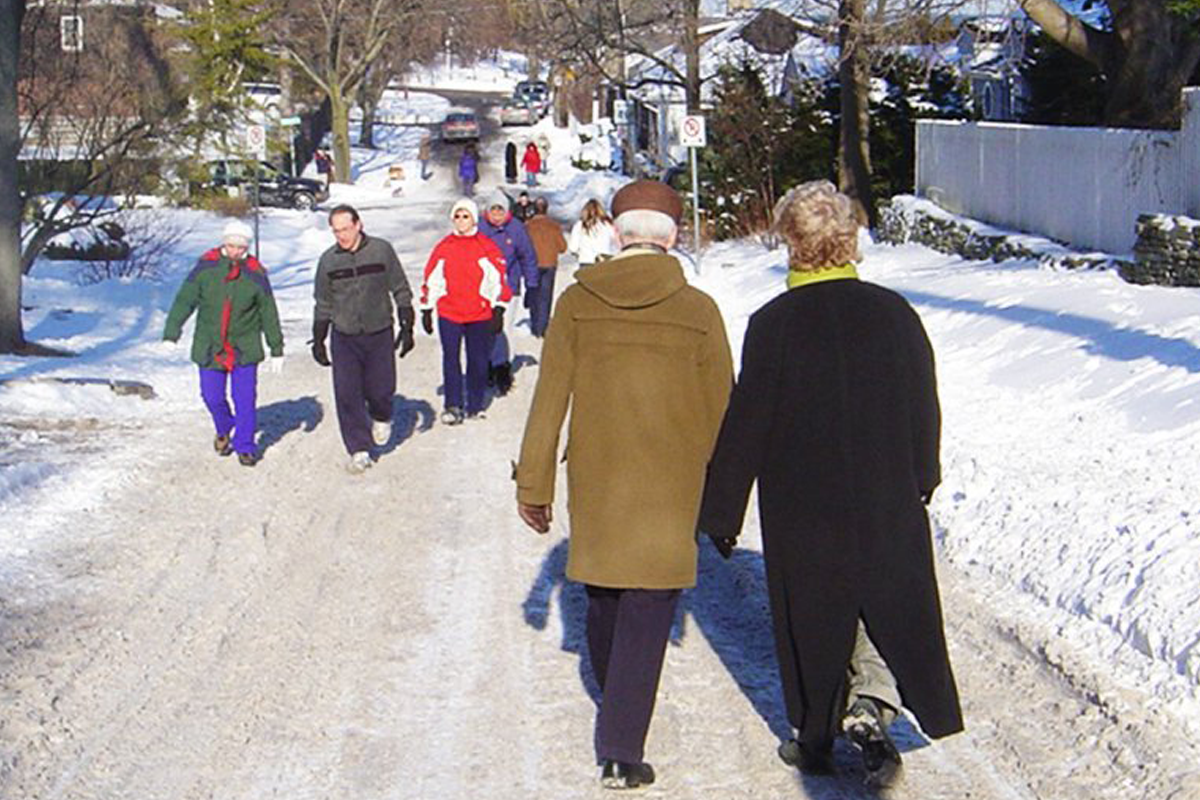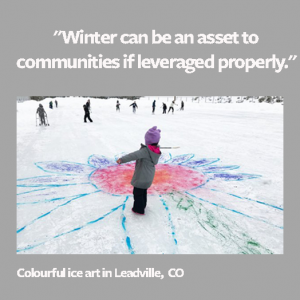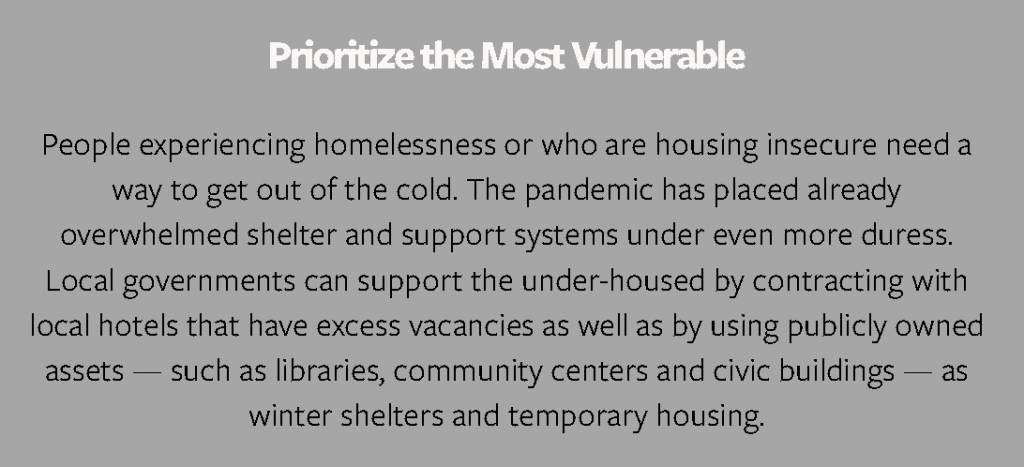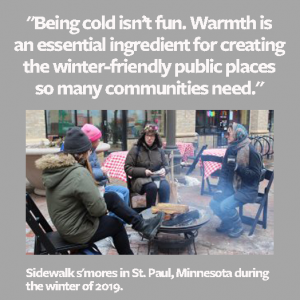
08 Dec Winter Is Coming: 6 Ways Local Leaders Can Help People Warmly and Safely Social Distance Outdoors During COVID-19
This article is a collaboration between 8 80 Cities and AARP Livable Communities.
Communities across the globe have adapted to the COVID-19 pandemic by re-imagining social gatherings — moving dining and other activities outdoors, for instance — where open spaces make social distancing easier. But winter is coming — or, in many places, has already arrived.
“We need to find new and creative ways to connect with one another outdoors where we can physically distance,” says Amanda O’Rourke, executive director of 8 80 Cities, a livability and public spaces advocacy organization — and frequent AARP Livable Communities partner — based in Toronto, Canada. “This is especially true for older adults, who are among the most susceptible to COVID, the most likely to report feeling socially isolated and the most likely to remain indoors during winter.”
 Although social isolation tends to increase for everyone during the winter, O’Rourke asserts, “we are misdiagnosing the issue by blaming winter. The problem is much deeper than that. Public spaces and transportation systems that are already forces for exclusion and social isolation become even more problematic in winter.”
Although social isolation tends to increase for everyone during the winter, O’Rourke asserts, “we are misdiagnosing the issue by blaming winter. The problem is much deeper than that. Public spaces and transportation systems that are already forces for exclusion and social isolation become even more problematic in winter.”
“The way we design, plan and manage our outdoor public spaces do very little to invite vibrant winter activity and public life,” she explains. “That’s the root cause, which, combined with the impacts of COVID-19, creates a perfect storm for mental and physical health crises. The good news is that winter can be an asset to communities if leveraged properly.”
According to O’Rourke and David Simor, a senior project manager at 8 80 Cities, local governments can make winter spaces inclusive and inviting for people of all ages by addressing the challenges caused by cold temperatures, winter light and accessibility and by “reframing the conversation about winter.” Their suggestions:
1. Clear sidewalks, bike lanes, and walking paths of snow and ice
Sidewalks are public spaces that improve mobility, accessibility and quality of life. Yet public works departments prioritize the clearing of snow and ice from roads while generally neglecting sidewalks. In fact, many cities don’t bother to clear sidewalks at all. Why devalue these important assets by leaving them inaccessible for three or four months of the year? Cities with accessible, active transportation networks — including sidewalks and bike paths — see high levels of physical activity and social connection in winter. Keeping sidewalks walkable and streets or paths bikeable during the COVID-19 pandemic can relieve crowding on public transit systems.
2. Make outdoor lighting “human scale”
For many people, one of the hardest parts of winter is the lack of sunlight. The decrease in daylight hours contributes to a higher rate of traffic collisions during the winter months. To combat the hazards, many cities increase the wattage of lighting along streets, sidewalks and public spaces. Some use lighting in fun ways by hosting festivals, competitions and art installations that brighten the night.

3. Design for winter by creating comfortable “micro-climates”
Being cold isn’t fun. Warmth is an essential ingredient for creating the winter-friendly public places so many communities need. Local governments, businesses and organizations can plan and design spaces for winter by installing warming zones and fire pits in places where people normally congregate for physical activity, such as parks and plazas, as well as in locations where people typically have to wait outdoors, such as transit stops. Such micro-climates can raise the surrounding air temperature by up to 15 degrees and both encourage and enable people to spend more time outdoors. When closed to vehicle traffic, street spaces can support social, physical and commercial activity through the use of heated patios and parklets.
4. Use snow and ice to a community’s advantage
The River Trail in Winnipeg, Manitoba, Canada, and the Rideau Canal in the nation’s capital city of Ottawa, Ontario, provide distinctive skating and recreational opportunities that connect large parts of each city. Communities with beautiful trail systems that teem with people in the summer can support safe recreational opportunities for walking, cross-country skiing, and fat-tire bicycling in winter. Leadville, Colorado, closes its downtown streets for cold-weather activities such as ski-joring (a sport in which a person on skis is pulled by a horse, dog or motor vehicle). Other cities close streets for tobogganing or Open Streets programs. Wintertime also creates opportunities for snow building and ice sculpture competitions.
5. Maintain park amenities
Properly maintained walking paths can boost physical activity levels for park users during the winter. But in many North American cities, parks are closed, or essentially closed, once cold weather arrives for the season. Restrooms are locked, paths aren’t cared for and event programming (see item 6) comes to a halt. Winterizing park restrooms is even more important during a pandemic when people have fewer options for accessing indoor washrooms (such as in libraries, community centers, stores or eateries). Older adults and families with young children are much less likely to visit a park or outdoor space if safe, clean toilets aren’t available and accessible. Places that invite people to spend time outside need to provide comfortable and clean restrooms.

6. Provide winter programs and activities
Another reason parks and public spaces see significantly fewer visitors during colder months is because many municipalities don’t host events and activities in winter.
Programming that would typically occur inside libraries or community centers can be moved outdoors. The activities that work best are ones that encourage people to move their bodies for both exercise and warmth, such as yoga, walking, tai-chi, dancing, golf and simple games for people of all ages to enjoy. It doesn’t take much effort or money to enable people to be active and healthy in winter. Following are just a few of the creative ways communities can woo people outdoors in winter:
- Host pop-up hot chocolate stands
- Install Little Free Library book and grocery giveaway boxes on lawns
- Place “wishing trees” and “kindness rocks” in neighbourhoods
- Organize volunteer snow-shovelling crews
For many people, the appetite for connecting with others has become stronger due to the forced isolation caused by the pandemic. Communities and local leaders can be catalysts and facilitators in support of socializing and social distancing in the cold — and during the winter, mask-wearing for avoiding infection provides the added benefit of warmth.
Page published December 2020 | A similar version of this article also appears on: AARP Livable Communities.



